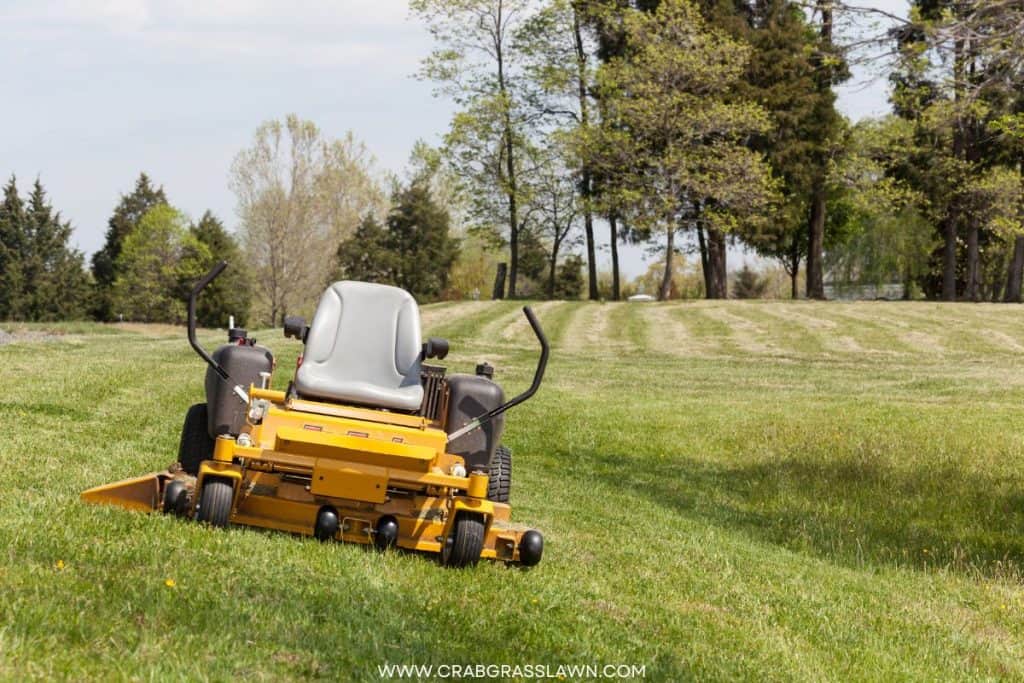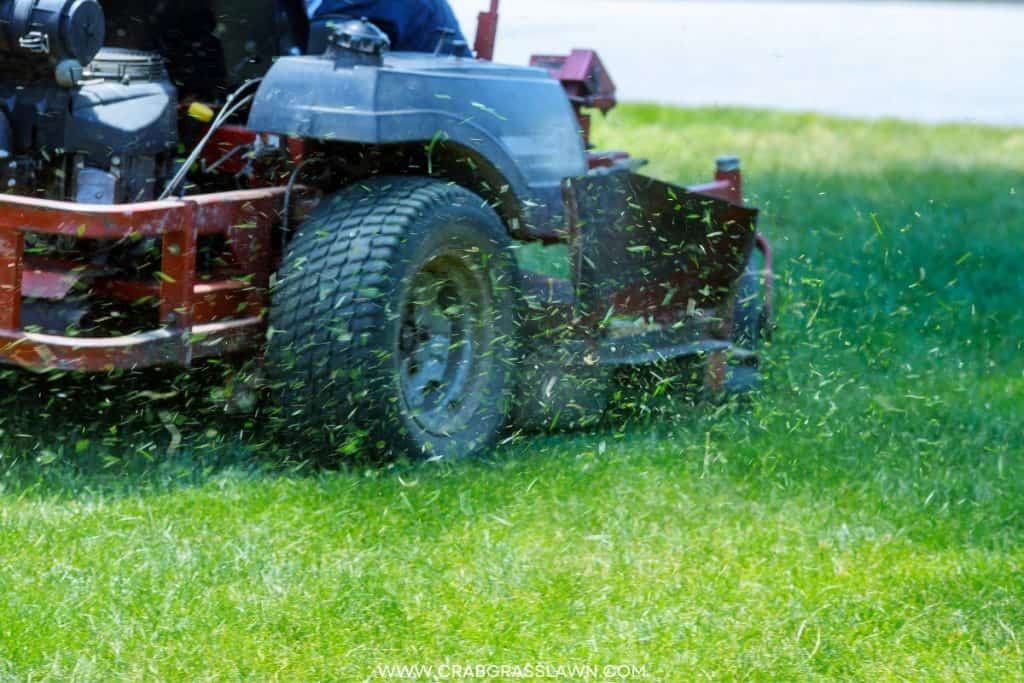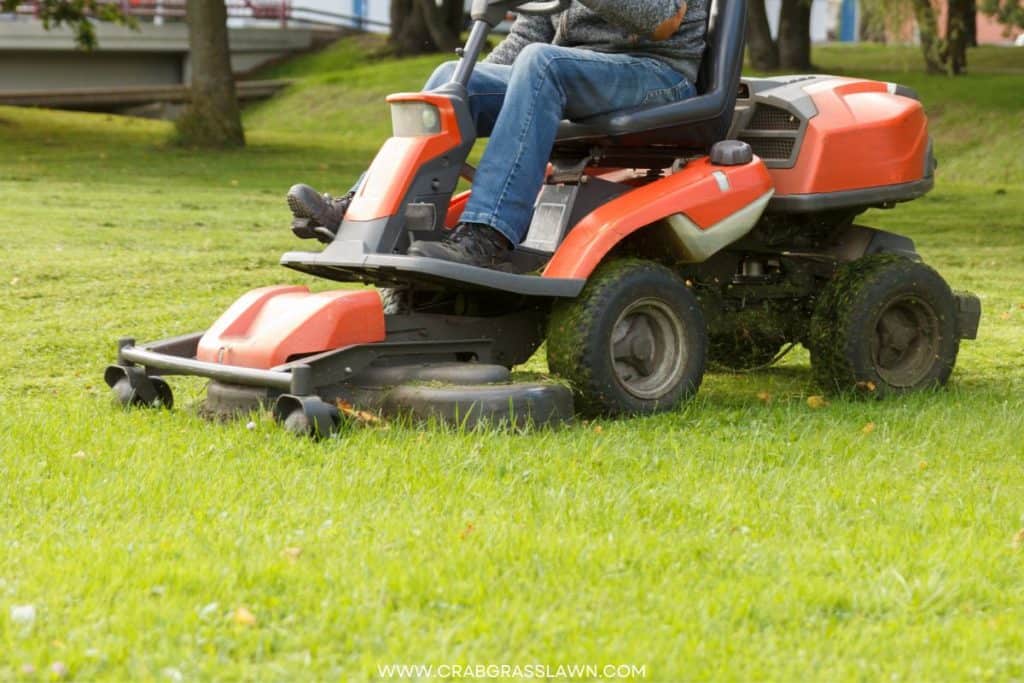There was a time not too long ago when zero-turn mowers were primarily used by lawn care companies that had to mow several yards in a short period to make money. That’s changed, as homeowners are increasingly adopting zero-turn lawn mowers to save time and to create visually appealing grass patterns with ease.
While zero-turn mowers are a great option for lawncare enthusiasts, they do come with a set of risks in operating that traditional push mower or riding mower options don’t have. Without further ado. let’s look at some of those risks and how to prevent them so you can safely enjoy your mower.

Optimal Driving and Environmental Conditions for Zero Turn Mower Use
There are some specific conditions that you should avoid using mowers. Using your mower in these conditions may result in serious damage to your mower and can compromise your safety.
This list includes some basic recommendations for mower riders. In addition to reading my advice here, I suggest taking some time to read your mower owner’s manual for additional tips or mower-specific safety information.
Mow When It’s Dry
This rule applies to all push mowers and riding mowers, but it’s especially true for those of you who choose to use a zero-turn mower. If nothing else, your mower deck and yard can get very messy when mowing wet grass. After mowing, you’ll have to clean your mower deck and all the clumps of wet grass left behind.
From a safety standpoint, mowing in wet conditions is generally bad because the mower wheels don’t gain the same traction on wet surfaces as on dry ones. Here are some reasons why you shouldn’t mow a wet lawn.
This advice is especially important for those of you who mow on hilly terrain. There are several dangers of rollover as highlighted in this article.
Slow Down
Most of us buy zero-turn mowers to speed up our mowing times. You can get carried away with this. If you use a zero-turn mower, ensure you are mowing at speeds you know you can safely handle. This becomes increasingly more important when mowing steep hills or areas you are unfamiliar with.
Turn Cautiously
One mistake that zero-turn mower operators make pretty frequently is the speed at which they turn. This seems to occur a lot in wide open spaces where zero-turn mowers should be easy to operate.
Operators move so fast moving forward that they underestimate how much they need to slow down to turn the mower carefully. When you approach your turn, slow down. As you become more familiar with your mower, you’ll know exactly how much or how little you will need to ease up.
Check Your Tires And Rear Brakes
You want to keep the wheels on anything you are riding in good shape. It becomes more important the faster and more maneuverable the vehicle becomes.
This will help provide easy maneuverability and keep you safe. Check your tires for good traction or excessive wear. Make sure your front wheels and rear wheels are free of debris and your tires are also properly inflated. Be sure to correct any issues that you find immediately. Here is a guide on lawnmower tire safety.
Your machine will have rear brakes that are designed to slow your machine’s rear wheels down or stop the mower in its tracks. Every time I start my machine, I do a quick rear brake check to ensure they are working properly. Most machines will not have brakes on the front wheels.

Safety Features
If you are shopping for new lawn tractors and are considering a zero-turn lawn mower, I suggest buying a machine with these features. While they won’t prevent all accidents from happening, they will help prevent a lot of them. Buying a mower without these safety features may save you some money in the short-term but can cost you a lot more later.
Seat Belt
Just like your car, our lawn mower should have a seat belt. Your seat belt will keep you in the mower seat if you suddenly have to stop while cutting grass.
Operators Presence Control System (OPSCS)
The OPSCS is many words describing the machine’s automatic seat safety switch. This system automatically shuts your machine blades down if you leave your seat.
Rollover Protection System (ROPS)
The ROPS system on a zero-turn mower is the roll bar that arches over the top of you on your mower. These roll bars keep you from getting crushed if your zero-turn mower is ever to be flipped over. You wouldn’t catch me getting on a zero-turn mower without a rollover protection system.
Wheel Or Counterweights
This may not be necessary for all zero-turn mowers. Make sure you ask about them when you purchase your machine. Often these are only necessary if you are using a bagging system.

Zero-turn Mower Operating Tips
Mowing Hills
We’ve already covered the dangers of using zero-turn mowers on wet hills. In addition to ensuring the hill that you are mowing is dry:
- Avoid mowing hills that are sloped more than 15 degrees.
- Never mow a hill across or against the hill.
- Always mow with the hill or up and down it.
Zero-turn mowers handle hills very well if you follow these tips.
Avoid Bodies of Water, Embankments, Ditches, and Other Unpredictable Surfaces
It’s tempting to mow right up against bodies of water to keep from having to use a push mower or trimmer to knock the grass down.
Doing this creates some avoidable dangers, however. Bodies of water often have ground that is very soft around them.
This is a great place to get the tires of your zero-turn mower stuck. Most zero-turn mowers can’t get out of these places; if they do, it will create a massive mess.
Embankments and ditches as much as possible. These areas are known to give zero-turn mower operators fits. Embankments can create unsafe slopes that are dangerous for zero-turn mowers to operate on. Ditches are an easy place to tip your mower into. Both should be avoided.
Give Yourself Plenty of Space
Zero-turn mowers are really good at moving around structures like retaining walls, mailboxes, telephone poles, etc.
Trying to cut in close can be tempting to avoid using a string edger to clean up what you don’t get with the mower. Getting too close can create unintended property damage; if you hit it hard enough, you can get hurt.
Use The Five-Foot Rule
When using mowers of any kind, it’s a good idea to give yourself plenty of space. How much space? As a general rule, I recommend 5 feet.
This may be accessible if mowing at slow speeds, and you may want to give yourself more if you are moving. 5 feet is a good general distance to keep to avoid accidentally hitting something or losing control and driving your mower into the water.
Zero-Turn Mower FAQ
Q: Which Is Safer, a Zero-Turn Mower or a Riding Lawn Mowers?
A: Generally, a riding mower will move at slower speeds and does not allow you to turn as quickly. They are also a lot less prone to rollover and tipping accidents. All of these accidents are completely avoidable on zero-turn mowers if you operate them safely and correctly.
Q: Can These Mowers Be Used to Pull Trailers or Other Lawn Implements?
A: I cautiously say yes. You’ll need to read your owner’s manual to determine how much and what types of implements your lawn tractor can pull. This is true with a traditional lawn tractor as well.
Q: Can Zero-Turn Mowers Be Used on a Hill?
A: In most cases, you can use the machine on a hill safely. Before you use a mower on a hill, you’ll want to review the safety information I’ve provided and read the owner’s manual that came with your mower for specific information.
The two biggest pieces of advice would be to avoid very steep slopes and mowing wet grass. It is easy to lose control of your machine in these two scenarios.
Q: Can You Buy an Electric Machine?
A: You sure can buy an electric mower. And as companies continue to improve electric technology, you are starting to see electric mowers that are as powerful and fast as their gas machine counterparts.
Q: Is It Hard to adjust from a Traditional Steering Wheel to a Zero-Turn Mower?
A: No. Not with a little practice. To practice, our best bet is to find a nice wide open space on flat ground. Practice taking a sharp turn without losing traction. As you gain confidence, practice taking multiple sharp turns, and increase to a speed where you do not lose control.
Q: Are These Machines Good for Flat Lawns?
A: These mowers do well on flat surfaces but can handle slopes very well too. A zero-turn mower will typically cut large lawns with a flat surface much faster than ride-on machines or a walk-behind mower.
Q: Who Shouldn’t Buy a Zero-Turn Lawn Machine?
A: If I owned a property that had a really steep hill or another steep slope that I had to navigate, I might avoid a zero-turn machine. Making zero turns can be dangerous on these slopes.
Final Thoughts
While there are some real dangers of zero-turn mowers, this doesn’t mean you should buy one. I own a zero-turn mower, and I prefer it over ride-on mowers I also own a push mower that I use around water or other permanent structures.
Operating your machine safely, ensuring that your wheels are fully inflated so you don’t lose traction, and carefully making your zero turns will go a long way in ensuring you stay safe while operating.
You May Also Like…
Best Zero Turn Mowers for Hills and Slopes
Best Commercial Zero Turn Mowers
Disadvantages of Zero Turn Mowers (That you NEED to know NOW)
EGO Z6 Zero Turn Riding Mower Review – First Thoughts & Unboxing Video
How to Replace the Drive Belt on a Husqvarna Zero Turn Mower
Hi, Alex Kuritz here. Growing up I remember that my family had one of the best lawns in the neighborhood. Richly green and lush. I did a lot as I grew up in terms of caring and tending for not only my family’s lawn but also my neighbors. I can say I have years of experience, and I am here to share it with you.


